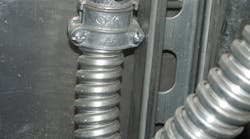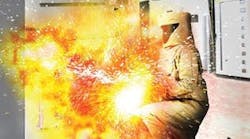All references are based on the 2017 edition of the NEC, unless otherwise noted.
I often see workbooks, graphics, and PowerPoint presentations where the author uses text saying that “transition” or “changeover” fittings, such as the one shown in the photo, must be accessible in a completed installation. They may cite this transition as a raceway or conduit termination while quoting Sec. 300.15(F) as the rule that requires this type of fitting to remain accessible. Well, I disagree with this view.
In my interpretation, Sec. 300.15(F) was never intended to apply to this type of fitting. For 300.15(F) to be applicable, the installer would be using this fitting in lieu of a box or conduit body as specified in Sec. 300.15. The problem with that logic is that Sec. 300.15 does not require boxes or conduit bodies to be installed at raceway or conduit terminations or transitions. Section 300.15 does, however, require a box or conduit body to be installed at conductor terminations — therein lies the problem.
Something has gotten lost in translation over the years since the words “termination point” were added to Sec. 300.15 in the 2002 Edition of the Code. I am acutely familiar with this rule change because it was my online conversation with the submitter that spurred him to submit proposal 3-83 in the May 2001 NFPA 70 Report on Proposals for Sec. 300.15(a). The substantiation for the change was to prohibit just taping the ends of an abandoned energized cable and leaving the cable end buried in a wall.
Here is the Code-Making Panel statement on related proposal 3-81: “The phrase ‘termination point’ was inserted where necessary in the text to ensure that live conductors that are capped for future use are also enclosed in a box or conduit body.” I think this clarifies that the words “termination point” were never intended to apply to raceway or conduit terminations. It was always meant to apply to conductor terminations.
Armed with this knowledge, one can make more sense of the requirements in the main body of Sec. 300.15 and see how a box is not required at a “raceway termination” and, therefore, this type of fitting is not being used in lieu of a box or conduit body. It is merely being used as a type of coupling; therefore, Sec. 300.15(F) need not apply.
As always, if you have any doubts about how the requirements of the NEC might be applied in your area, it’s always best to have a conversation with your local AHJ.




